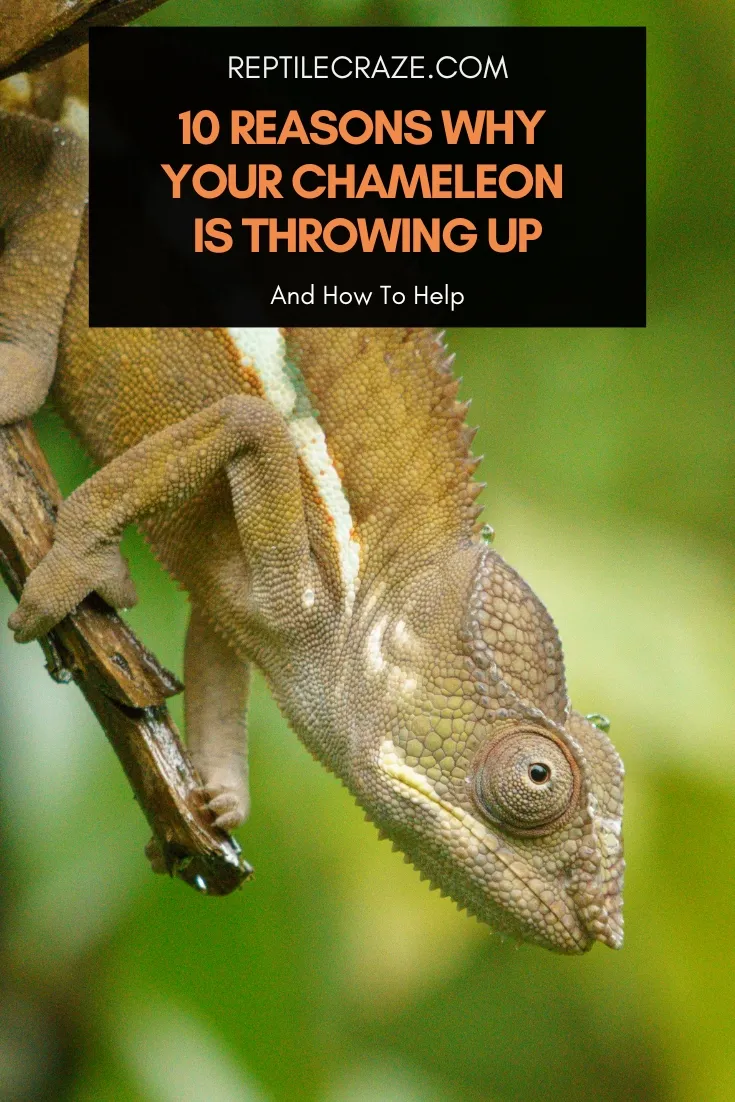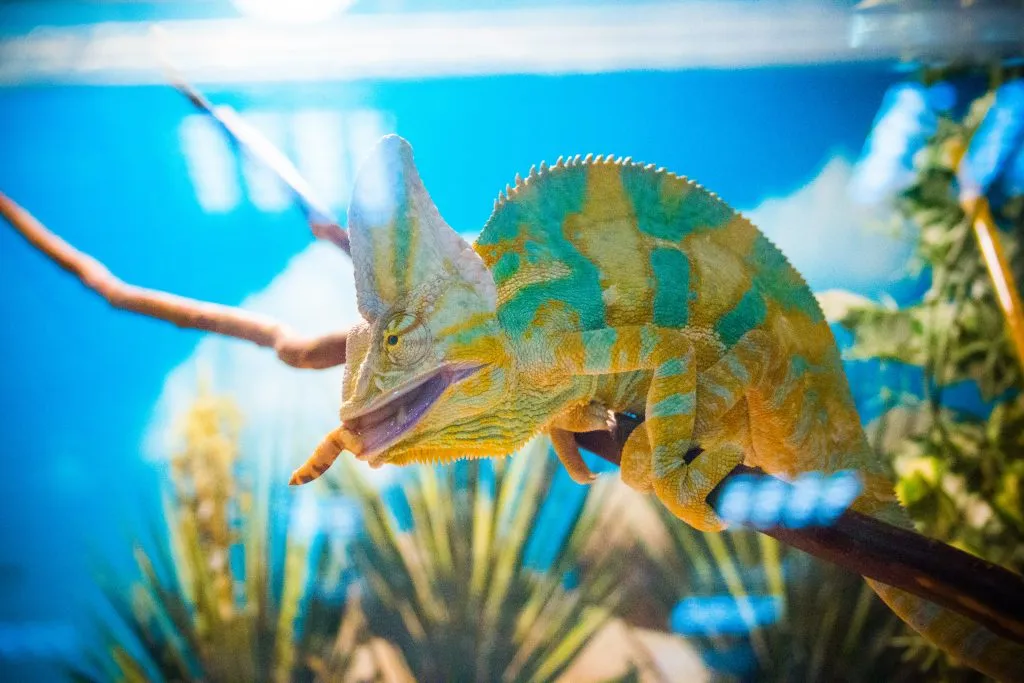
Chameleons throwing up is always almost a cause for concern. Unfortunately, there are quite a few reasons why this might happen, which usually leaves owners panicked and confused. We’re here to help though.
Chameleons vomit for a lot of reasons, but the most common ones include overeating, internal parasites, and impaction. Hydration and fixing any obvious husbandry issues are usually the first steps to help your pet, though veterinary intervention is required in serious cases.
This post provides a comprehensive list of all the possible reasons a chameleon might throw up, and steps you can take to help your pet feel better. Read on!
Table of Contents
Why Your Chameleon Might Be Throwing Up
Before we jump into the causes, it’s important to understand the difference between regurgitation and vomiting.
Regurgitation happens when stuff from the esophagus is ejected, while vomiting is throwing up contents of the stomach and upper intestine, which may not be fully digested.
Regurgitation is not always serious and has easy fixes but vomiting is almost always an alarming situation. That said, let’s talk about why this happens to chameleons:
Too Much Food

Although chameleons usually stop eating when they’re full, some species, especially veiled chameleons, can eat too many insects in one go, causing them to choke and regurgitate.
Their stomachs are pretty small and can’t hold much
Eating large insects like big crickets can also make them throw up, so it’s always better to opt for smaller-sized
Drinking Water Too Fast
Chameleons are used to drinking gentle dripping water from leaves, so if they drink water too quickly, it can cause them to regurgitate.
Since chameleons have no sphincters separating the esophagus and stomach, drinking too much at once can also cause them to vomit the water along with the contents of the stomach.
Parasites
‘Parasites’ is an umbrella term to represent the various types of harmful organisms that affect your pet.
The ones that might result in vomiting are internal parasites that reside in the digestive tract, such as coccidia, or intestinal nematodes like roundworms.
The parasitic nature of these organisms can cause your chameleon to throw up whatever you try to feed it, have runny poops, and feel lethargic. Read our article here if your chameleon seems to be lethargic.
Decreased or unusually increased appetites are a symptom too, also resulting in vomiting.
If you’ve been feeding your cham wild-caught insects or you haven’t been cleaning up poop from its
Tip: It’s important to get regular fecal floats done to test for parasites, even if your chameleon doesn’t have any symptoms.
Swallowed Tongue
Although not as common, chameleons can swallow their tongues, which might happen due to a Vitamin B complex deficiency.
This can often make them vomit, though they don’t usually display any obvious symptoms after swallowing their tongues.
In worse cases, the tongue can be damaged with stomach acids or even be fully digested. It’s an alarming and painful situation that requires an emergency visit to a vet.
Also read: 6 Reasons Why Your Chameleon Is Shaking
Late Feedings
Many new owners often don’t know that it’s never okay to feed a chameleon in the afternoon or at night.
This is because chameleons need to soak in basking light to properly digest
This results in either vomiting or pooping out partially digested insects. It’s not healthy, neither is it a pretty sight.
It’s best to feed them in the morning or by noon at most while providing basking temperatures between of 85-95 degrees (for commonly owned species like veiled and panthers).
Ingesting Substrate

If you have substrates like coconut fibers or wood chips in the enclosure, there’s always a chance your chameleon will ingest it.
In fact, it’s quite common for chameleons to do this, either accidentally when trying to catch insects or deliberately due to dietary deficiencies.
Even soil in potted plants can be eaten, which almost always results in vomiting. If you have dead leaves laying around at the bottom, or pieces of tree bark, remove them to prevent your cham from swallowing them.
This is especially possible with young chameleons who will often try to taste almost everything in the
Tip: Chameleon enclosures don’t really need substrates (despite what the folks at the pet store tell you). Just a layer of newspapers should be enough.
Impaction
Sometimes, the ingested substrate can result in medical emergencies like impaction, which is when there’s a blockage in the digestive tract.
This often results in chameleons throwing up whatever they try to eat because the
Impaction can also happen due to constipation, so keep your eyes peeled for symptoms like vomiting, not passing stool for days, and a decreased appetite.
Kidney Failure
Chameleons with renal failure don’t display obvious signs of illness, especially during the initial stages.
However, in the advanced stages of the disease, they’ll lose their appetite and vomit or regurgitate whatever you try to feed it, along with other symptoms like sunken eyes and lethargy.
The condition is hard to detect and develops silently, so it’s better to do all you can to prevent it from happening.
Prolonged dehydration, excessive minerals in the diet, and improper husbandry all cause chronic kidney failure.
Tip: If you fear your chameleon might be dehydrated, read our article on that here! It will show you the symptoms of dehydration and what you should do now.
Respiratory Infections
Captive chameleons are prone to respiratory infections, especially in poorly ventilated enclosures.
This can cause excessive mucus to be discharged from the mouth (and nose), which looks a lot like vomiting but it really isn’t.
An unmistakable sign of a respiratory infection is when a chameleon elevates its head and sticks out its nose in the air. If you see your pet doing this along with excessive saliva-like discharge from the mouth and ‘popping’ sounds in its breath, rush to a vet ASAP.
Unhygienic Food and Enclosure

Have you fed your chameleon any wild-caught insects? Are the store-bought ones raised in hygienic conditions? Are the enclosure and any items like bowls and decor cleaned regularly?
These are some questions you must ask yourself to determine what may have caused your pet to vomit. Poor hygiene in the
Meanwhile, insects sourced from unreliable stores can carry parasites inside them.
All of this can cause your pet’s tummy to become upset, resulting in vomiting, diarrhea, and much worse symptoms.
Helping a Chameleon Feel Better After it Vomits
Most of the time, chameleons throwing up requires a visit to the vet, but in the meanwhile, here are some steps to assess the situation and help your pet feel better:
Examine the Vomit
Take a close look at what your chameleon threw up. If the
And if you find any substrate in the vomit (or poop), remove the substrate from the enclosure immediately.
Hydrate
The next step is to hydrate the chameleon, especially if you think excessive water isn’t the cause. Vomiting can lead to dehydration, and there’s nothing worse than a dehydrated chameleon.
Check its urates for yellow-orange colors, which indicates dehydration. Even if the urate is white, it’s a good idea to provide water to your pet before anything else.
Use a syringe or a small pipette to slowly hydrate your chameleon one drop at a time, and it will feel and look much better soon after this.
Tip: Mixing one part water with one part electrolyte solution (without sugar) offers quicker hydration. Alternatively, you can also use coconut water. Also, read our article on how to make your chameleon drink water.
Hold Off Feeding
It’s best to hold back from feeding your chameleon for the rest of the day after it vomits. This allows the tummy to settle down before the next meal.
Start with a light, appropriate-sized feeding the next morning to see if your chameleon can digest it. Remember not to go for something fatty like wax worms!

If your chameleon seems to be hungry and enjoying the
If it’s not interested in the
Your chameleon likely has parasites or other underlying conditions that can only be diagnosed and treated by a certified vet.
Ensure Proper Husbandry
In the meanwhile, check if the chameleon’s enclosure is well-maintained.
Since they’re one of the most delicate reptiles to exist, wrong temperatures and low humidity can affect chameleons and their health to a great extent.
In case you have a veiled chameleon, here’s a complete guide on ensuring an appropriate enclosure for veiled chameleons.
Any shortcomings in the setup should be corrected ASAP to provide a safe and stress-free environment for your pet to heal and recover in.
Do note that temperature and humidity requirements vary between species.
Rush to an Emergency Vet

If you suspect any of the following, take your chameleon to an emergency vet immediately without waiting for an appointment:
- Abdominal swelling, likely due to impaction, kidney failure, and other serious conditions
- Respiratory infections
- Swallowed or damaged tongue
- Extreme lethargy with closed eyes and/or inability to grip onto branches
- Frequent vomiting (multiple times a day)
Your vet will get fecal exams and blood work done, alongside x-rays and a physical exam.
Intravenous fluids might be given to rehydrate your pet and stabilize it, after which the vet will decide on an appropriate treatment plan and give at-home care instructions.
Final Thoughts
It’s important to determine whether the cause behind your chameleon throwing up is serious by noticing other signs and symptoms it displays, so you can seek medical help in time.
Because chameleons tend to hide their illnesses until it’s too late, it’s always better to take them to a vet to ensure they’re healthy.
- Enchi Ball Python: A Unique and Stunning Morph of Python regius - March 27, 2025
- Emerald Tree Monitor: The Enigmatic Green Guardian of the Rainforest - March 26, 2025
- The Egyptian Cobra (Naja haje): A Fascinating Serpent - March 25, 2025
